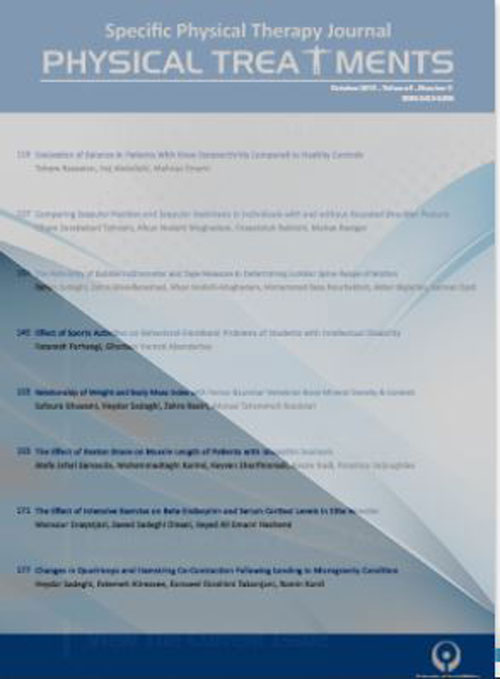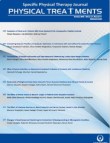فهرست مطالب

Physical Treatments Journal
Volume:9 Issue: 2, Spring 2019
- تاریخ انتشار: 1398/01/12
- تعداد عناوین: 7
-
-
Pages 69-76Purpose
As many older people fall during dual tasks, we aimed to examine the effect of different cognitive loads on learning gait stability in younger and older adults.
Methods10 younger (Mean±SD age: 25.91±3.42 years) and 10 older adults (Mean±SD: 66.65±4.28 years) were healthy volunteers without a history of falls. They were asked to do three tasks on a treadmill with cognitive load (none, simple, and complex). The Gait-stability Ratio (GSR) was calculated in each condition. Two-way repeated-measures ANOVA was used to examine the mean differences at a significance level of 0.05.
ResultsThe findings showed that high cognitive load behavior during preferred speed walking in the younger and older adults decreases walking speed, and subjects learn to achieve greater stability. It was determined that by applying different cognitive loads (none, simple, and complex), the GSR value in older adults was higher than younger adults (P<0.01).
ConclusionThe results showed that the older adults, through different walking strategies, especially the lowering phase, provide double support while walking so that they fall less with increasing steadiness. Also, walking exercises along with complex cognitive load can help older adults to better motor control.
Keywords: Walking, Cognitive Function, Balance -
Pages 77-84Purpose
Dynamic stability reduces in patients with unilateral amputation; so, it is important to recognize changes in balance during walking. This study aimed to investigate the dynamic stability of unilateral below-knee amputation during walking.
MethodsThe present study was a quasi-experimental study, in which 10 patients with knee amputation and 10 healthy young people participated. The variables of the present study included spatiotemporal variables, center of mass (COM) variables in anteroposterior, and mediolateral directions, as well as stability margin variables in anteroposterior and mediolateral directions. The COM and marginal stability variables were extracted through Visual 3D software. The data were analyzed by independent and dependent t-tests, using SPSS V. 22 at a significance level of 0.05.
ResultsThe mean difference between COM and the COP in the amputation group in the frontal plane on both sound and prosthetic sides was significantly higher than those in the healthy group (P=0.01). The difference in COM and COP in the toe-off phase of the amputation group in the sagittal plane on the prosthetic side was significantly less than that in the healthy group (P<0.01).
ConclusionThe amputees suffer from poor dynamic stability during walking; so, they increase the positive margin of stability in the frontal plane and decrease the negative margin of stability in the sagittal plane. These patients decreased the excursion of COM in the sagittal and frontal plane, thereby using different gait patterns. However, the threats of falling in these patients are more than that of the healthy ones. Therefore, it is recommended to improve the dynamic stability of these patients in the frontal plane.
Keywords: Dynamic stability, Amputation, Margin of stability, center of mass -
Pages 85-96Purpose
This study aimed to compare the effectiveness of physiotherapy with uphill walking versus physiotherapy alone on the disability of patients with knee osteoarthritis.
MethodsThis study was a randomized clinical trial carried out on 30 patients (5 males and 25 females) with moderate knee osteoarthritis aged between 40 and 65 years. They were assigned to the intervention and control groups. Both groups received 10-session routine physiotherapy, and the intervention group received an 8-degree treadmill walking at a speed of 1.1m/s for 30 minutes in each session. The participants’ disability was measured before, immediately after, and 20 days after the 10-session treatment by the Persian version of Knee injury and Osteoarthritis Outcome Score (KOOS). The data were analyzed through the repeated measures analysis of variance in SPSS V. 22. The significant level was set at 0.05.
ResultsStatistical analysis showed significant improvements in the activity of daily living (P≤0.01) and quality of life (P<0.05) in both groups, with these improvements being persistent up to the 20th day (P<0.02). Other subscales included Symptoms, pain, and sports functions improved only in the intervention group (P≤0.01), and these improvements were persistent up to the 20th day (P≤0.003).
ConclusionThis study showed that physiotherapy combined with uphill walking versus physiotherapy alone results in improvements in pain, other symptoms, and sports function subscales of patients with moderate knee osteoarthritis. These improvements were persistent up to the 20th day. Accordingly, it is recommended to include an 8-degree inclined treadmill walking to the routine physiotherapy program in the management of knee osteoarthritis.
Keywords: Knee osteoarthritis, Contracture, Walking, Exercise -
Pages 97-106Purpose
The purpose of this study was to compare the effect of a fatigue protocol on some kinematic gait parameters in students with genu valgum, genu varum and normal people.
MethodsSamples of this study included 37 high school students (age 16.39 years, height 172.42 cm, weight 71.10 kg) who participated voluntarily in the study and were divided into three groups of genu valgum (n=13), genu varum (n=12) and normal (n=12). In order to evaluate the alignment of the lower extremity, goniometry-based quadriceps angle (Q) measurement was performed and the kinematic parameters were evaluated by a 10-m walk test using KINOVEA software.
ResultsIntragroup comparison results showed that there were significant differences in stance time, swing time, step length, walking speed, number of steps and walking distance between all three groups after inducing the fatigue protocol (p<0.001), while intergroup comparison results showed significant differences between the three groups only in terms of stance time, swing time, and stride length after applying the fatigue protocol (P<0.001).
ConclusionThe present study showed that the fatigue protocol can affect kinematic gait parameters in people with knee abnormalities and those with normal alignment, and these effects differ in some parameters between normal subjects and those with genu varum and genu valgum.
Keywords: Fatigue, Genu valgum, Genu varum, Kinematics, Gait -
Pages 107-116Purpose
Sensory systems play an essential role in motor control. The lack of information about each of these systems can affect postural sway. This study aimed to assess balance recovery during the manipulation of somatosensory, visual, and vestibular systems in deaf persons.
MethodsThirty healthy and deaf subjects were selected as samples. Balance recovery strategies in various situations were recorded by 6 high-speed cameras after a sudden movement of the treadmill. The Independent t-test was used for data analysis (P≤0.05).
ResultsThe results of this study showed that the mean of hip and ankle swings in different conditions was significantly higher in the deaf group than the healthy group except for the reference position, both in the anterior-posterior and posterior-anterior perturbations. However, there was no significant difference between the ratios of hip-to-ankle swings in all situations except for the third position.
ConclusionThe findings of this study showed that the effectiveness of all sensory systems involved in balance recovery in healthy people was significantly better than the deaf persons. The dominant sensory system for restoring balance in healthy people is the visual, somatosensory, and vestibular systems, respectively. While deaf people have a greater reliance on somatosensory information and, then, the visual system. The negative effect of the weakness of visual information in the process of staring can be useful in reducing the effectiveness of the visual system in balance control of the deaf persons.
Keywords: Deaf, Somatosensory system, Vision system, Vestibular system, Balance recovery strategies -
Pages 117-124Purpose
Extracorporeal shockwave therapy (ESWT) is a relatively new method in the treatment of musculoskeletal disorders such as plantar fasciitis. This study aimed to compare two methods of treatment with extracorporeal shockwave and stretching in athletes with chronic plantar fasciitis.
MethodsThe study was a randomized clinical trial. A total of 30 male athletes with chronic plantar fasciitis voluntarily participated in this study. The subjects were randomly divided into two groups; ESWT (n=15) and stretching exercises (n=15). Both treatment methods were applied once a week for five weeks. Pain, the range of motion (ROM) of the ankle joint, and the strength of the plantar flexors of the ankle were assessed, using visual analog scale (VAS), goniometer, and dynamometer before and after the interventions.
ResultsVAS scores significantly decreased in both groups after the treatment (P<0.001). Furthermore, after the treatment, the ROM and the strength of plantar flexors increased dramatically in both groups (P<0.001). There were no significant between-group differences at any time (P>0.05).
ConclusionThis study suggests that both methods of stretching and ESWT are suitable methods for improving the symptoms in chronic plantar fasciitis. There was no significant difference in the effect of both types of treatment. According to the results, stretching is easier, non-invasive, and less costly method. So, it seems to be a preferable method for ESWT. However, more studies are required because of the limitations of this research.
Keywords: Chronic plantar fasciitis, Extracorporeal shockwave therapy, Passive Stretching, Visual analog scale -
Pages 125-136Purpose
This study aimed to evaluate the effects of a selected course of the core stabilization of body and hopping exercises on trunk strength and balance of female Kabaddi athletes.
MethodsThe subjects of this study consisted of 24 female Kabaddi players, who were randomly selected and intentionally assigned to two groups; experimental group (12 persons; Mean±SD age: 16.83±1.26 years, height: 1.61±0.04 m, weight: 56.50±3.06 kg, BMI: 21.84±1.73 kg/m2, and exercise history: 05.08±1.08 years) and control group (12 persons; Mean±SD age: 16.42±0.99 years, height: 1.60±0.05 m, weight: 59.08±8.68 kg, BMI: 23.03±1.71 kg/m2, and exercise history: 5.25±1.60 years). The experimental group performed a 6-week training program, 3 sessions per week, each session consisting of 40 minutes of core stabilization exercises and hopping. A questionnaire was used to collect demographic information and exercise history, and the Y-balance test and stork stand balance test were used to measure static and dynamic equilibrium, respectively. In addition, the strength of the core part was evaluated by trunk 60° flexion, Biering-Sorensen, forearm plank, and side plank (right and left) tests. The Shapiro-Wilk test was used to check the normality of the data. In the case of normal data, the paired t-test was used to evaluate the differences in mean values.
ResultsThe results of this study showed a significant difference between the mean posttest scores of trunk strength and static and dynamic balance in both experimental and control groups (P<0.001) so that the subjects in the experimental group performed better in these tests. All statistical tests were performed at a significance level of 95% (P<0.05).
ConclusionThe results of the present study show that combined balancing exercises for the core part of the body and hopping can improve the balance and endurance of the Kabaddi athletes and, thus, may prevent potential injuries.
Keywords: Kabaddi, Core stability, Hopping, Trunk endurance, Static balance, Dynamic balance


